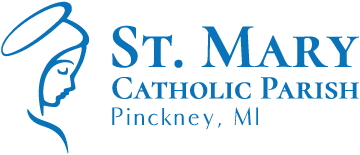The death of St. John the Baptist means his mission as the Precursor, the one crying out in the wilderness, is finished. This news sends Jesus to a deserted place to pray and reflect on the next stage of his own mission. But his solitude is very brief, as the crowds are there to meet him with their many needs.
Jesus could have stayed in the boat and rowed back out to sea for the prayer time he needed. He could have refused to step off the boat into the vast crowd of need. But he never draws back from loving generously, fully, personally. He is moved with pity for them and spends the whole day talking with them, hearing their pleas, curing their illnesses, encouraging them.
At the end of this long day, undoubtedly fatigued, the disciples suggest that Jesus send them all away to feed themselves (probably thinking that they – and Jesus – could then get some rest!). But Jesus is not done giving; he is never done giving. And he is not done teaching either; he is never done teaching. So he uses this as a teachable moment for the people and the disciples, telling the disciples to give them something to eat.
I like to imagine the look on the faces of the disciples, the glances they gave each other and the confusion they felt when they considered how to feed thousands of people with five loaves of bread and two fish. Focused on their own incapacity and shortage, they were not yet relying fully on the Lord’s power. But they were about to learn a profound lesson: no matter how little they have, when they put it into the Lord’s hands, it becomes more than sufficient! Jesus tells them: “Bring them here to me.”
Then he takes the loaves and fish, looks up to heaven and says the blessing, breaks the bread, and gives it to the disciples. Sound familiar? The four verbs used to describe what Jesus does are the same four verbs used to describe what Jesus will do at the Last Supper, and the same four verbs used to describe what the priest does at every single Mass: he took, blessed, broke, and gave the bread. And their meager supplies became, mysteriously, more than enough to feed the thousands of people who came to him that day. In fact, there were 12 baskets of leftovers.
The same is true for us: no matter how little we have, when we put it wholly into the Lord’s hands, it becomes more than enough! And when we receive the Eucharist, we have a profound opportunity to put everything, including our whole self, into the Lord’s hands. If we give generously, we can be confident that we will lack nothing! How can we open ourselves and offer ourselves fully to the Lord the next time we receive Communion?
La muerte de San Juan Bautista significa que su misión como Precursor, aquel que clama en el desierto, ha terminado. Esta noticia envía a Jesús a un lugar desierto para orar y reflexionar sobre la siguiente etapa de su propia misión. Pero su soledad es muy breve, ya que las multitudes lo buscan allí para satisfacer sus múltiples necesidades.
Jesús podría haberse quedado en la barca y remado de regreso al mar durante el tiempo de oración que necesitaba. Podría haberse negado a bajar del barco hacia la gran multitud de personas necesitadas. Pero nunca deja de amar generosa, plena y personalmente. Se compadece de ellos y pasa todo el día hablando con ellos, escuchando sus súplicas, curando sus enfermedades, y animándolos.
Al final de este largo día, sin duda fatigados, los discípulos sugieren que Jesús los envíe a todos a alimentarse (probablemente pensando que así ellos – y Jesús – podrían descansar un poco). Pero Jesús no ha terminado de dar; nunca termina de dar. Y tampoco ha terminado de enseñar; nunca termina de enseñar. Él utiliza esto como un momento de enseñanza para el pueblo y los discípulos, diciéndoles que les den algo de comer.
Me gusta imaginar la expresión de los rostros de los discípulos, las miradas que se lanzaban unos a otros y la confusión que sentían al considerar cómo alimentar a miles de personas con cinco panes y dos peces. Centrados en su propia incapacidad y escasez, todavía no confiaban plenamente en el poder del Señor. Pero estaban a punto de aprender una lección profunda: por poco que tengan, cuando lo ponen en las manos del Señor, ¡se vuelve más que suficiente! Jesús les dice: “Tráiganmelos acá”.
Luego toma los panes y los peces, mira al cielo y dice la bendición, parte el pan y se lo da a los discípulos. ¿Suena familiar? Los cuatro verbos que se utilicen para describir lo que hace Jesús son los mismos cuatro verbos que se utilicen para describir lo que Jesús hará en la Última Cena, y los mismos cuatro verbos que se utilicen para describir lo que hace el sacerdote en cada Misa: tomó, bendijo, partió, y les dio el pan. Y la poca comida que tuvieron volvió misteriosamente más que suficiente para alimentar a las miles de personas que acudieron a él ese día. De hecho, quedaron 12 cestas de sobras.
Lo mismo ocurre con nosotros: no importa lo poco que tengamos, cuando lo ponemos totalmente en las manos del Señor, ¡se vuelve más que suficiente! Y cuando recibimos la Eucaristía, tenemos una profunda oportunidad de poner todo, incluido todo nuestro ser, en las manos del Señor. ¡Si damos generosamente, podemos estar seguros de que nada nos faltará! ¿Cómo podemos abrirnos y ofrecernos plenamente al Señor la próxima vez que comulguemos?
Kathryn Mulderink, MA, is married to Robert, Station Manager for Holy Family Radio. Together they have seven children (including Father Rob), and eight grandchildren. She is President of the local community of Secular Discalced Carmelites and has published five books and many articles. Over the last 30 years, she has worked as a teacher, headmistress, catechist, Pastoral Associate, and DRE, and as a writer and voice talent for Catholic Radio. Currently, she serves the Church by writing and speaking, and by collaborating with various parishes and to lead others to encounter Christ and engage their faith. Her website is www.KathrynTherese.com
Feature Image Credit: Coffee-king, pixabay.com/photos/bread-food-fresh-baked-crust-1750987/



